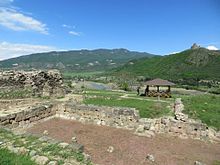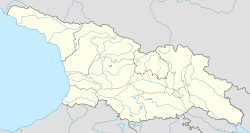31:
58:
217:
51:
205:
blocks forming an impregnable base but were finished off by less durable mud brick. It also contains a great hall of six columns with a tiled roof. Armazi II is noted for a temple with an apse. Armazi III is the richest layer constructed of elegantly cut stone blocks, joined together with lime mortar and metal clamps. Among the surviving structures are the royal palace, several richly decorated tombs, a bathhouse and a small stone mausoleum.
347:
201:, resumed in 1985 and continuing. These have shown that the adobe town walls and towers, built upon a plinth of hewn stone in the first half of the 1st century AD, surrounded the hill top and the side sloping down towards the river, an area of 30 ha. The land within the walls was terraced and various buildings were sited on the terraces.
255:
of the pagan
Iberian pantheon. He was either a shortened form of Armazd or Ahur Mazda, the Zoroastrian God. Or he was derived from the Vedic God Armah which means the Moon God in Sanskrit. The latter is thought to be the correct one because of the findings of moon god relics. The name first appears
204:
The three major cultural layers have been identified: the earliest dates back to the 4th-3rd century BC (Armazi I), the middle one is from the 3rd-1st century BC (Armazi II), and the relatively newer structure belongs to the 1st-6th century AD (Armazi III). Armazi I is constructed of massive stone
192:
Minor excavations on the territory of Armazi carried out in 1890 revealed the plinth of adobe town walls, with stone steps, and cleared the two-room structure, where fragments of a woman's torso of the 1st century AD were discovered. From 1943 to 1948 large-scale excavation was undertaken under
419:
in the late 5th or early 6th century, Armazi went into a gradual decline. It still had its own high-ranking commandant, a post held in A.D. 545 by a certain Wistam. The city was finally destroyed and razed to the ground in 736 by the
408:-Aramaic tombstone inscription commemorating the short-lived Serapita and her noble lineage. It contains an unusual, in its ductus and some of its forms, version of the Aramaic alphabet which came to be known as the "
338:
in 75 AD. This defense wall constructed in a unique position to block the southern exit of the Daryal Pass before it widens into the plain of modern
Tbilisi was presumably a preventive measure against the
323:. A ruined structure over the Mtkvari River dates from that time and is still called "Pompey's bridge". Armazi's heyday came when Iberia was allied with the Roman emperors.
668:
663:
658:
653:
224:
Archaeological evidences testify that the ancient Armazi was far more extensive than it is today. Armazi's strategic situation was dictated by its ready access to the
172:. A part of historical Greater Mtskheta, it is a place where the ancient city of the same name and the original capital of the early Georgian kingdom of
633:
678:
400:
Armazi played a central role in ancient
Georgian cultural life and in the evolution of local epigraphy in Georgia, prior to the invention of the
673:
582:
643:
487:
369:, and was second in the official Iberian hierarchy after the king. The excavations of the hereditary necropolis of this dynasty yielded
450:
which, as well as its associated structures, is now largely in ruins and only some fragments of the 12th-century murals have survived.
300:(წიწამური) or Sevsamora of the Classical authors, stood just opposite, on the left bank of the Aragvi and controlled the road towards
208:
The area is now a state-protected field museum administered as a part of the
National Archaeology Museum-Reserve of Greater Mtskheta.
612:
638:
602:
93:
533:
276:. According to a collection of medieval Georgian chronicles, Armaztsikhe was founded, in the 3rd century BC, by king
592:
404:
in the 5th century. Among a number of curious inscriptions found at Armazi, the most important is the bilingual
683:
30:
552:
198:
505:
593:
The
Bilingual Inscription from Armazi (1st century AD) (Greek and Aramaic texts with German translation)
525:
324:
50:
350:
335:
307:
Even after the rise of
Mtskheta as a capital of Iberia, Armazi remained the holy city of Iberian
17:
561:
491:
596:
648:
608:
277:
247:, Armaz-Tsikhe (literally, "citadel of Armazi"; არმაზციხე), is usually taken to derive from
545:
256:
in the early medieval
Georgian annals though it is clearly much older and reflected in the
180:
was located. It particularly flourished in the early centuries AD and was destroyed by the
8:
483:
425:
257:
628:
586:
529:
439:
401:
320:
161:
151:
81:
409:
394:
386:
229:
177:
556:
374:
265:
194:
216:
405:
285:
36:
622:
328:
289:
108:
95:
412:" although it can also be found outside Armazi, in other parts of Georgia.
370:
312:
301:
293:
248:
506:
Georgian
Museums: National Archaeology Museum-Reserve of Greater Mtskheta.
385:
150 AD), a rare example of authentic, pre-Christian
Georgian portraiture.
447:
273:
225:
297:
311:
and one of the defenses of
Mtskheta. The fortress was captured by the
390:
358:
331:
244:
237:
233:
343:
who frequently raided the Roman frontiers from across the Caucasus.
443:
346:
308:
165:
549:
389:
inscriptions from Armazi mention also the royal architect and the
459:
429:
416:
382:
378:
362:
269:
169:
446:
was constructed there between 1150 and 1178. This is a six-apse
509:
Ministry of Culture, Monuments Protection and Sports of Georgia
432:
366:
316:
281:
261:
173:
77:
340:
252:
438:
The city of Armazi has never been revived since then, but a
421:
181:
357:
During this period, Armazi was governed by a hereditary
35:
The ruins of a six-column hall in the Armazi palace on
319:during his 65 BC campaign against the Iberian king
669:Populated places disestablished in the 8th century
664:8th-century disestablishments in Georgia (country)
659:Populated places established in the 4th century BC
654:4th-century BC establishments in Georgia (country)
620:
377:(probably the contemporary of the Roman emperor
155:
583:Historical monuments of the Mtskheta District
415:With the transfer of the Georgian capital to
373:bearing portraits of two of these viceroys,
29:
634:Archaeological sites in Georgia (country)
479:
477:
475:
679:Tourist attractions in Mtskheta-Mtianeti
345:
284:. This fortress stood on the modern-day
215:
621:
615:2009-10-25). Photos by Revaz Zhghenti.
472:
334:fortified Armazi for the Iberian king
243:The name of the city and its dominant
522:The Roman Empire: Augustus to Hadrian
361:, whose rank approximated to that of
674:Buildings and structures in Mtskheta
514:
327:unearthed in 1867 reports that the
292:(Kura), at its confluence with the
13:
644:Former cities in Georgia (country)
14:
695:
597:Open Society – Georgia Foundation
573:
566:. Accessed on September 13, 2007.
511:. Accessed on September 13, 2007.
496:. Accessed on September 13, 2007.
56:
49:
280:at the place hitherto known as
260:name Armastica or Harmozica of
220:The ruins of the Armazi citadel
539:
499:
187:
57:
1:
465:
639:Museums in Georgia (country)
199:Georgian Academy of Sciences
7:
453:
288:, on the right bank of the
10:
700:
526:Cambridge University Press
381:, 117-138 AD) and Zevakh (
211:
15:
520:Sherk, Robert K. (1988),
325:Armazi stele of Vespasian
228:, the main road over the
156:
137:
132:
124:
87:
73:
44:
28:
589:Regional Administration.
603:Ruins on Mount Bagineti
351:Armazi stele of Serapit
168:and 22 km northwest of
18:Armazi (disambiguation)
555:July 12, 2008, at the
354:
221:
184:invasion in the 730s.
684:736 disestablishments
349:
296:. The other citadel,
278:Pharnavaz I of Iberia
219:
595:The Armazi Project.
562:Encyclopædia Iranica
546:Lang, David Marshall
492:Encyclopædia Iranica
484:Lang, David Marshall
236:invaded the ancient
232:, through which the
164:, 4 km southwest of
65:Shown within Georgia
16:For other uses, see
426:Marwan ibn Muhammad
105: /
25:
355:
222:
23:
587:Mtskheta-Mtianeti
440:Georgian Orthodox
402:Georgian alphabet
160:) is a locale in
145:
144:
109:41.817°N 44.667°E
39:(1st century BC).
691:
605:. Fund "Udabno".
581:
567:
543:
537:
518:
512:
503:
497:
481:
395:Lord Chamberlain
230:Greater Caucasus
159:
158:
120:
119:
117:
116:
115:
110:
106:
103:
102:
101:
98:
60:
59:
53:
33:
26:
22:
699:
698:
694:
693:
692:
690:
689:
688:
619:
618:
579:
576:
571:
570:
557:Wayback Machine
544:
540:
519:
515:
504:
500:
482:
473:
468:
456:
214:
195:Andria Apakidze
190:
113:
111:
107:
104:
99:
96:
94:
92:
91:
69:
68:
67:
66:
63:
62:
61:
40:
21:
12:
11:
5:
697:
687:
686:
681:
676:
671:
666:
661:
656:
651:
646:
641:
636:
631:
617:
616:
606:
600:
590:
575:
574:External links
572:
569:
568:
564:Online Edition
538:
513:
498:
494:Online Edition
470:
469:
467:
464:
463:
462:
455:
452:
286:Mount Bagineti
213:
210:
189:
186:
143:
142:
139:
135:
134:
130:
129:
126:
122:
121:
114:41.817; 44.667
89:
85:
84:
75:
71:
70:
64:
55:
54:
48:
47:
46:
45:
42:
41:
37:Mount Bagineti
34:
9:
6:
4:
3:
2:
696:
685:
682:
680:
677:
675:
672:
670:
667:
665:
662:
660:
657:
655:
652:
650:
647:
645:
642:
640:
637:
635:
632:
630:
627:
626:
624:
614:
610:
607:
604:
601:
598:
594:
591:
588:
584:
580:(in Georgian)
578:
577:
565:
563:
558:
554:
551:
547:
542:
535:
534:0-521-33887-5
531:
527:
523:
517:
510:
507:
502:
495:
493:
489:
485:
480:
478:
476:
471:
461:
458:
457:
451:
449:
445:
442:monastery of
441:
436:
434:
431:
427:
423:
418:
413:
411:
410:Armazi script
407:
403:
398:
396:
392:
388:
384:
380:
376:
372:
371:engraved gems
368:
364:
360:
352:
348:
344:
342:
337:
336:Mithridates I
333:
330:
329:Roman Emperor
326:
322:
318:
314:
310:
305:
303:
299:
295:
291:
290:Mtkvari River
287:
283:
279:
275:
271:
267:
263:
259:
254:
250:
246:
241:
239:
235:
231:
227:
218:
209:
206:
202:
200:
196:
185:
183:
179:
175:
171:
167:
163:
153:
149:
140:
136:
131:
127:
123:
118:
90:
86:
83:
79:
76:
72:
52:
43:
38:
32:
27:
19:
649:Razed cities
609:Mt. Bagineti
560:
541:
524:, p. 128-9.
521:
516:
508:
501:
490:
437:
435:Marwan II).
428:(the future
414:
399:
356:
306:
302:Mount Kazbek
251:, the chief
242:
223:
207:
203:
191:
147:
146:
448:hall church
274:Dio Cassius
226:Daryal Pass
188:Archaeology
112: /
88:Coordinates
623:Categories
550:"Asparukh"
466:References
424:commander
298:Tsitsamuri
133:Site notes
128:Settlement
488:"Armazi".
391:epitropos
359:pitiakhsh
332:Vespasian
258:Classical
245:acropolis
238:Near East
234:Scythians
138:Condition
629:Mtskheta
613:Archived
553:Archived
454:See also
444:St. Nino
375:Asparukh
315:general
309:paganism
166:Mtskheta
152:Georgian
141:In ruins
74:Location
460:Dzalisi
430:Umayyad
417:Tbilisi
387:Aramaic
379:Hadrian
363:viceroy
270:Ptolemy
212:History
197:of the
170:Tbilisi
162:Georgia
100:44°40′E
97:41°49′N
82:Georgia
585:. The
532:
433:Caliph
367:satrap
317:Pompey
294:Aragvi
282:Kartli
262:Strabo
249:Armazi
178:Iberia
174:Kartli
157:არმაზი
154::
148:Armazi
78:Kartli
24:Armazi
406:Greco
397:").
341:Alans
321:Artag
313:Roman
266:Pliny
253:deity
530:ISBN
422:Arab
272:and
182:Arab
125:Type
383:fl.
365:or
176:or
625::
559:.
548:.
528:,
486:.
474:^
393:("
304:.
268:,
264:,
240:.
80:,
611:(
599:.
536:.
353:.
150:(
20:.
Text is available under the Creative Commons Attribution-ShareAlike License. Additional terms may apply.


